Pipes for domestic sewage in the house: a comparative overview of modern types of pipes
Uninterrupted operation of the sewer system depends on a competent choice of components and the correct installation of the network. Often, home craftsmen equip engineering systems on their own and are faced with a priority question: which pipes for sewage in a house are better in technical and financial terms.
We will help to understand a difficult question. In the article proposed by us, all types of pipes used are described, their positive and negative sides are listed. The material is systematized so that it is easier to compare product characteristics, service life, cost and application practice.
The content of the article:
Requirements for Pipes
Sewerage system of the house - a network of engineering communications, designed to drain sewage from private and high-rise buildings. The movement of waste is carried out spontaneously in accordance with gravitational laws. The entire communication complex includes a network of internal and external piping.
The internal sewage system consists of plumbing fixtures, filter units for pre-treatment of wastewater, pipelines, risers, collectors and branch lines located within the house.
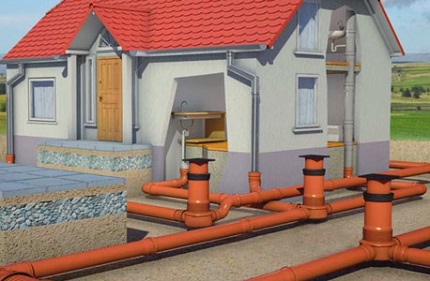
Operating conditions, technical parameters, pipe prices for outdoor and indoor installation differ from each other.The sewer network in the house does not experience intense load and is used in gentle conditions - the pipeline is laid inside the building and closed with decorative panels.
Basic requirements for an intra-house drainage line:
- Strength. Despite the “facilitated” operating conditions, the pipes must withstand mechanical loads and the pressure of the waste fluid flows.
- Bio and heat resistance. The material of manufacture must be chemically inert to aggressive components (cleaning products, etc.) contained in the withdrawn masses. Important - resistance to high temperatures.
- Smoothness. Lack of gaps of an internal covering of a pipe provides unhindered movement of waste. Even minor roughnesses over time cause a reduction in the bore and clogging of the sewage system.
- Convenience of installation. Light weight and ease of connection of individual elements facilitate the assembly of the drain line.
An additional requirement is the compatibility of the internal pipeline with the sanitary facilities of the room and the elements of the external sewer network.
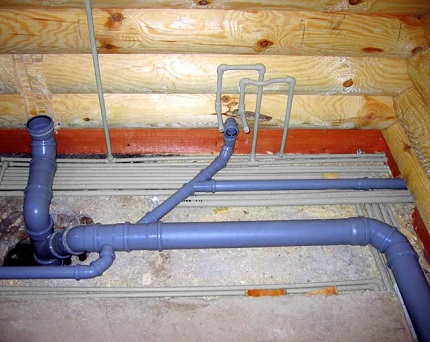
When choosing pipes for domestic sewage Three main criteria should be taken into account: material of manufacture, section diameter and manufacturer. Let us dwell in more detail on each of the parameters.
Technical and operational characteristics of different pipes
Two categories of pipelines are most popular: cast iron and plastic modifications. Over the past ten years, cast-iron pipes have lost the lead to polymer counterparts due to their corrosion resistance, reliability and lightness.
Cast Iron - Durability and Strength
The basis for the manufacture of cast iron pipes is iron ore. Some characteristics of the material correspond to the properties of steel, but due to the high oxygen content, cast iron products are characterized by increased wear resistance.
In the manufacture of sewer pipes, the centrifugal and semi-continuous casting technique is used. The first method allows casting "reinforcement" of any diameter, length and thickness. According to GOST, all outlet pipes are equipped with sockets.
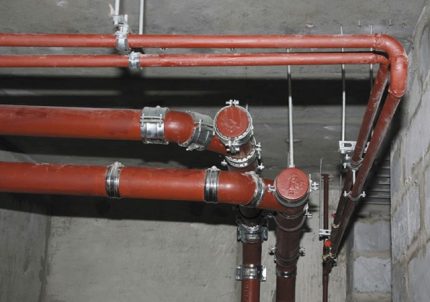
Advantages of cast-iron systems:
- high strength subject to installation rules;
- environmental Safety;
- good indicator of sound insulation;
- wear resistance;
- preservation of the form during the entire service life;
- fire resistance;
- resistance to different temperatures, atmospheric changes, chemicals and mechanical factors.
In order to prevent the appearance of a corrosive “plaque” the pipes and fittings mounted on them are treated from the inside with oil bitumen or enameled. In addition, this measure somewhat smoothes the roughness of the cast-iron surface.
Despite the strong arguments in favor of the traditional material, the high cost and laboriousness of installation work led to a decline in demand for cast iron pipes.
Additional disadvantages:
- the presence of roughness, contributing to the appearance of deposits and blockages;
- susceptibility to point impact.
To ensure complete sealing of the line, it is necessary to precisely adjust the linear dimensions of the connecting parts.
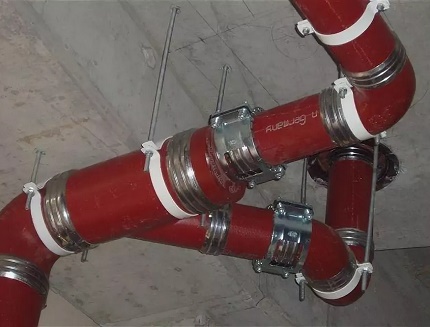
Polyvinyl chloride - practicality
Polyvinyl chloride is a thermoplastic polymer that is resistant to acidic compounds, solvents, alkaline substances and mineral oils. The operating temperature range ranges from -15 ° C to + 66 ° C. Due to its technical properties, the material is used in the production of pipes for laying internal pressureless sewers.
The most promising raw materials for the production of sewer and water pipes, experts consider unplasticized polyvinyl chloride (vinyl plastic) - a type of PVC with a more rigid structure.
Distinctive features of NPVH pipes:
- Duration of operation. Due to its resistance to corrosion processes and the "indifference" to chemicals, the service life is tens of years.
- The ease of the pipeline. Due to the low specific gravity, the material has a small weight, which facilitates and accelerates the assembly of the sewer line.
- The smoothness of the coating. Absolutely flat, without any roughness, the inner surface reduces the risk of clogging of the pipeline.
- Arrangement of complex paths. A wide selection of mounting elements simplifies the design and installation of intricate drainage lines.
- Affordable cost compared to metal counterparts.
Compared to steel, copper and polyethylene pipes, PVC products are characterized by high physical and biological inertness.
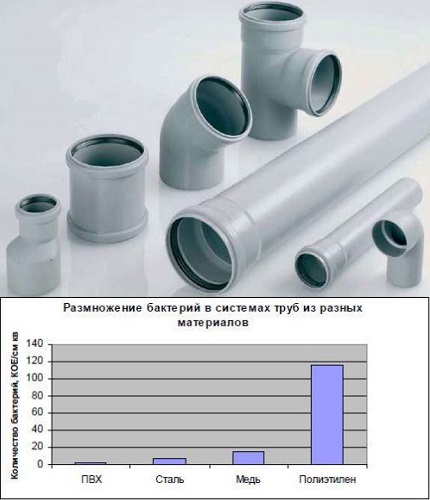
It is convenient to reconstruct the PVC system if it is necessary to install additional plumbing and "tapping" the outlet pipe to the common riser.
Giving preference to PVC highways, you should consider the nuances:
- with prolonged high-temperature exposure (70 ° and above), the plastic becomes brittle;
- concentrated organic solvents are able to "corrode" and change the structure of PVC.
PVC and PVC-reinforcement contains chlorine. When burning, plastic smokes and emits corrosive toxic substances.
Polypropylene - resistance to adverse effects
Polypropylene pipes are superior to polyvinyl chloride in some respects. Advantages of PP products:
- The elasticity of the material explains the resistance of pipes to mechanical shocks - polypropylene is slightly deformed, maintaining integrity, and is restored to its original state.
- Suppose contact with an acidic environment. This quality increases their wear resistance and allows us to talk about the safe disposal of PP waste.
- High rate of heat resistance. Allowable exposure temperature up to + 90 ° С, with a short-term increase to + 100 ° С, the PP-highway retains the declared qualities.
Frost resistance depends on raw material additives and the quality of pipe products. The spread of indicators within 10-50 ° C is below zero.
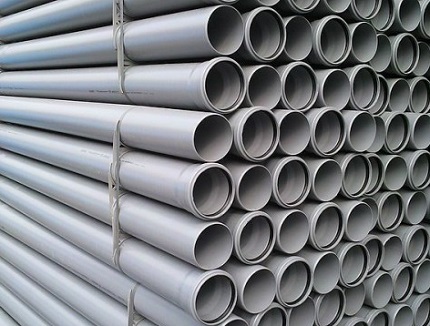
The above characteristics are characteristic of products manufactured in accordance with GOST. Here the question of choosing a manufacturer will play a paramount role.
Basic information about the characteristics of a PP pipe can be found in its marking. Knurling is applied over the entire length of the product with an interval of 2-4 m.
Marking displays:
- brand name;
- type of raw material (B - block copolymer, R - random copolymer, PP - polypropylene, H - homopolymer);
- outer diameter (10-1200 mm), wall thickness;
- permissible working pressure.
It should be remembered that a thicker PP-pipe wall should correspond to a high rate of nominal pressure.
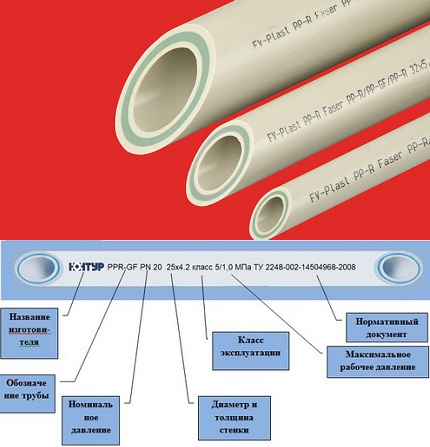
Polyethylene - Product Flexibility and Availability
When wondering which pipe to use for home or apartment sewerage, it is worth paying attention to products made of polyethylene (PE). The material is formed during the polymerization of ethylene with the addition of catalysts.
Operational characteristics depend on the qualitative composition and conditions of the reaction (pressure and temperature). HDPE pipes are used for the sewer line.
Polyethylene obtained by the polymerization of hydrocarbons under low pressure has the following characteristics:
- recommended operating temperature - not more than + 40 ° С, short-term jumps up to + 60 ° С are permissible;
- the ability to expand by 5-7% of the initial state explains the flexibility of the material and resistance to shock;
- low thermal conductivity - the formation of condensate on the pipes is minimal;
- lack of reaction in contact with transported waste of different origin (organics, chemicals).
Polyethylene pipes have many inherent advantages of the “plastic line”: low cost, corrosion resistance, lightness of material and ease of assembly of the sewage engineering network.
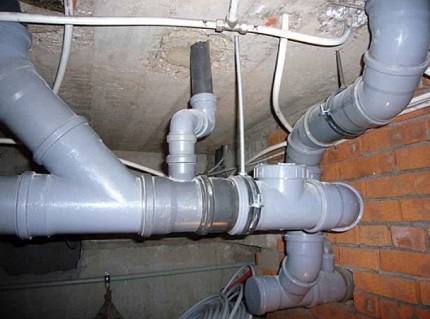
PE products are inferior to PP and PVC pipes in terms of wear resistance - with regular abrasive exposure to trash, the surface of the polyethylene is quickly worn away.
Steel - “rigidity” of the sewer line
Steel pipes provide strength and rigidity of the engineering network. The material retains the slope of the system and withstands high temperature loads.
However, the disadvantages of steel sewers are more serious:
- susceptibility to decay - when used to drain gray drains, painting or bitumen treatment is required; applying a waterproofing layer reduces the resistance to temperature from 700 ° C to 60 ° C;
- pipe joining is performed by threaded connection or welding - both methods make steel more vulnerable to corrosion.
The steel line is characterized by a high frequency of clogging - the diameter of the pipeline narrows due to the appearance of rusty deposits.
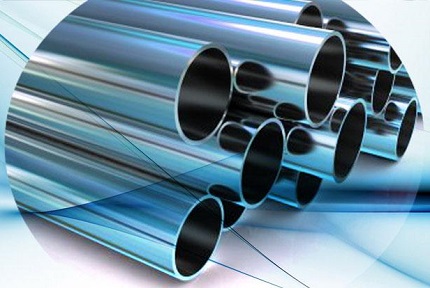
Alternative materials: asbestos cement and ceramics
Asbestos-cement and ceramic pipelines are rarely installed in private households and apartments. However, it is worth noting their technical and operational nuances.
Asbestos-cement pipes are made on the basis of Portland cement and asbestos fibers. Due to the complexity of installation, limited standard sizes and low strength, their use in sewer system not relevant.
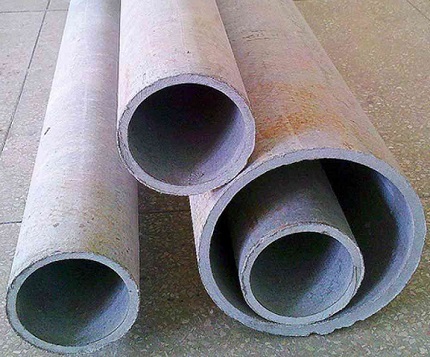
Technical parameters of ceramics slightly exceed the quality of cast iron pipes:
- resistance to corrosion - 100%;
- immunity to alkaline, acid compounds and other aggressive components;
- temperature resistance - ceramics can withstand temperatures of 1000 ° C or more;
- dimensions - 15-60 cm, wall thickness - 19 mm.
Ceramic pipes are in little demand due to the high cost and difficulties of self-assembly of the engineering network.
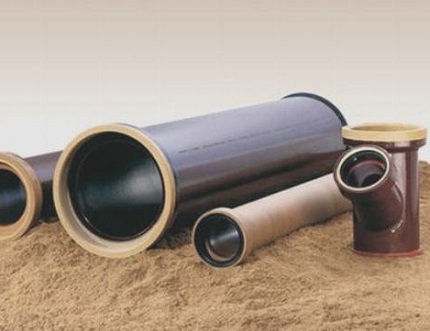
Diameter selection according to building codes
Unlike cast iron products, a number of plastic shaped modifications are much richer. Manufacturers polymer pipes produce products with diameters from 16 mm to 6000 mm.
The need for a diverse assortment makes sense:
- the possibilities of pipeline engineering systems are expanding;
- the pipe size is selected taking into account certain tasks;
- it is possible to replace the main section of the highway with a pipe with the smallest possible diameter - when laying the sewage system of a private house, this will reduce the budget for repairs.
The most common sizes for the internal drainage network: 50/100/150 mm.
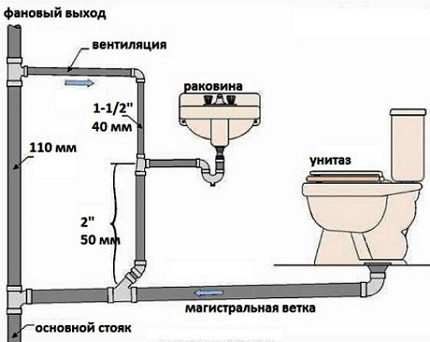
The scope of the pipes based on the bore:
- 16-25 mm - discharge of uncontaminated fluid from air handling units, air conditioners and dehumidifiers;
- from 32 mm - connection of a washbasin or sink used to wash conditionally clean dishes (glasses, wine glasses, etc.);
- from 40 mm - drain for bath, shower, kitchen sink, dishwasher or washing machine;
- 50 mm and more - simultaneous connection of shower and bath, laundry;
- 60-75 mm - combined connection of three and five devices, respectively, with the exception of the toilet.
Dimensions are measured from the inside and display the conditional passage of the highway. Given the wall thickness, the external value exceeds the internal size.
In addition to the diameter, when choosing polymer pipes, attention should be paid to the following points:
Leading manufacturers of internal pipe
To determine which pipes are best used for sewage, you should compare the characteristics and prices of products from leading pipeline systems companies. Market leaders are firms: Rehay, Wavin, Ostendorf, Politek, Politron and Corsis.
Rehay Raupiano - Silent Sewer
The German company Rehay has developed multilayer pipes - Raupiano Plus.
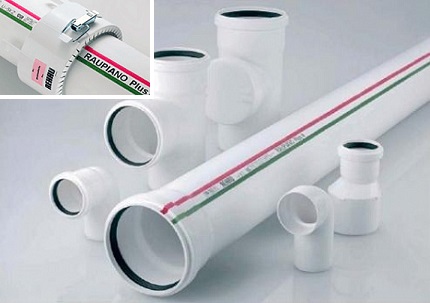
A track record of benefits:
- improved sound insulation - sound absorption efficiency increased by 30%;
- aesthetics - white pipes fit various room designs;
- reliability - multi-layer provides protection against leaks, shock and the appearance of an unpleasant odor;
- flexibility - floor and wall mounting possible.
Raupiano Plus - products for universal sewage, compatible with adapters and pipe fittings from other manufacturers. To increase the heat resistance of polypropylene, the manufacturer proposes to install fire cuffs that block the spread of fire through the engineering system (sensor response temperature - 120 ° C).
Wavin - plastic piping systems
Wavin is a European leader (Netherlands) with forty years of experience in manufacturing polymer pipes for water supply, sewage, drainage and storm water disposalunderground cable laying. The company has gained a reputation as an innovator and supplier of high-quality products.
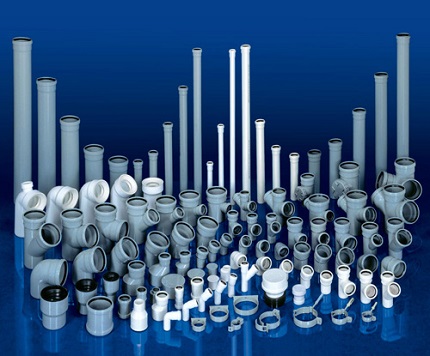
Product Features:
- sizes - 32-110 mm;
- raw materials of manufacture - PP and PVC;
- thickness - 2.6 mm;
- pipes with a section of 50, 100 mm are available in a two-bell version;
- resistance to temperature: 75 ° С - constant contact, 95 ° С - short-term exposure;
- white and gray color.
Wavin Asto Systems - Premium sound absorbing sewer. The wall thickness is 5.3 mm with a diameter of 110 mm. The thick pipe holds noise and suppresses acoustic vibrations. Heat resistance reaches 90-95 ° С.
Ostendorf HT - sound absorbing polypropylene
Ostendorf (Germany) specializes in the production of pipes and fittings for arranging sewage.

Products with noise reduction properties are made on the basis of polymer and mineral compounds.
Thanks to new technology, it was possible to improve the acoustic quality and strength indicator. Range of products - pipes with a section of 50-200 mm, product length - up to 3 m.
Politek - domestic products
The company specializes in the production of component polymer pipelines. The products meet European standards, each batch undergoes laboratory tests, the results of which are supported by a certificate.
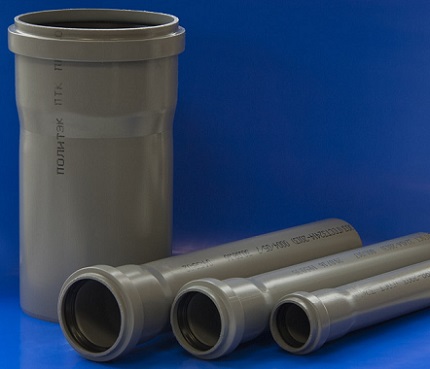
Characteristics of the internal sewerage Polytek:
- increased ring strength due to the two-layer pipe structure;
- good temperature resistance - 70 ° C;
- models: pipes with a bell and without;
- sizes: 32/40/50/110 mm, wall thickness - 1.8-2.7 mm.
Polytech products are resistant to chemicals, therefore it is recommended for internal wiring of the sewer line at production sites, in hospitals, laboratories and commercial buildings.
Conclusions and useful video on the topic
Video # 1. Comparison of sewer pipes designed for arranging the external and intra-house sewage network:
Video # 2. Assessment of the effectiveness of the silent sewage Raupiano and Skolan:
From the point of view of financial benefits and practicality, polypropylene pipes are the best choice for organizing the internal part of the sewage system. PP pipeline is affordable, easy to implement and guarantees uninterrupted long-term operation of the new engineering system.
Please write comments in the block below. Tell us about which pipes were used to repair the sewer system in the apartment or to lay the system in a country house. Ask questions, share useful information, post a photo on the topic of the article.

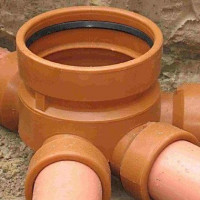 Sewer pipes PVC and HDPE for outdoor sewage: types, characteristics, advantages and disadvantages
Sewer pipes PVC and HDPE for outdoor sewage: types, characteristics, advantages and disadvantages 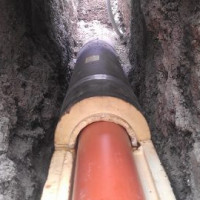 Insulation for sewer pipes: types, selection rules and overview of laying technology
Insulation for sewer pipes: types, selection rules and overview of laying technology 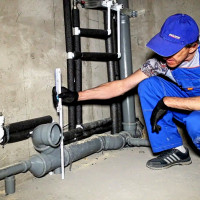 Do-it-yourself replacement of sewage in the apartment: detailed instructions for replacing the riser and pipes
Do-it-yourself replacement of sewage in the apartment: detailed instructions for replacing the riser and pipes 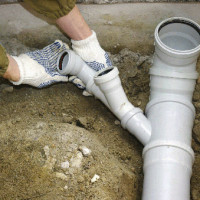 How to lay sewer pipes in a private house: schemes and rules for laying + installation steps
How to lay sewer pipes in a private house: schemes and rules for laying + installation steps 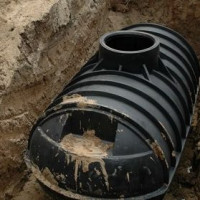 Sewerage in a private house: an overview of the options for arrangement + a step-by-step guide
Sewerage in a private house: an overview of the options for arrangement + a step-by-step guide 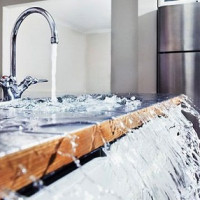 How to clean sewer pipes in a private house: varieties of blockages and methods of cleaning
How to clean sewer pipes in a private house: varieties of blockages and methods of cleaning  How much does it cost to connect gas to a private house: the price of organizing gas supply
How much does it cost to connect gas to a private house: the price of organizing gas supply  The best washing machines with dryer: model rating and customer tips
The best washing machines with dryer: model rating and customer tips  What is the color temperature of light and the nuances of choosing the temperature of the lamps to suit your needs
What is the color temperature of light and the nuances of choosing the temperature of the lamps to suit your needs  Replacement of a geyser in an apartment: replacement paperwork + basic norms and requirements
Replacement of a geyser in an apartment: replacement paperwork + basic norms and requirements
They built a house about twelve years ago, then there was not much variety. Sewerage was made from what we find. Basically, we have pig-iron pipes, but since they were building for a long time, polypropylene products began to appear. Therefore, we have a hybrid sewage system. But sometimes you want to change the cast-iron pipes to the polymer version. True, there have never been any failures or blockages. Decided that the best is the enemy of the good.
A few years ago I changed the old radian sewage system in the house for new pipes. Oh, and I had to sweat then. There was an option to connect old pipes with new ones, so as not to break everything and everything, but I refused it. Better done once, but for years to come.Moreover, the apartment is old; nobody has changed anything in it since the days of the USSR. I put polyethylene pipes, since they are inexpensive and, in my opinion, high-quality. I am more than satisfied with the work done - there are no blockages, the water descends quickly and without problems.
For the production of HDPE pipes (low-pressure polyethylene) use the “secondary”, so the quality is poor. In my opinion, it is better to choose other types of polymer. They are more reliable.
Hello! Why is polyethylene pipe more susceptible to bacterial colonies than PVC pipe?
Hello. Here it is all about the structure of the material itself. Conventional polyethylene has an average biological stability. By itself, this material is not affected by microorganisms, but exposure to UV radiation activates the multiplication of microorganisms in the pipeline. Therefore, it is necessary to protect the PE pipeline from direct sunlight.
As for polyvinyl chloride, its biological stability is below average, this is due to the rough structure of the pipeline, which contributes to the formation of deposits. Actually, this becomes a favorable environment in which microorganisms will develop. At the same time, PVC pipes show high resistance to ultraviolet radiation.
I attach a table with comparative characteristics of pipes from different materials. Resistance to the effects of biological organisms below (B- high, C- medium, H- low).